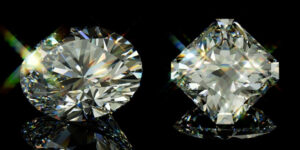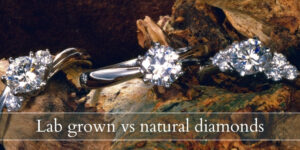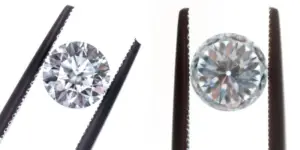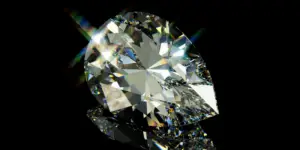Looking into antique diamond cuts ? Then you might be wondering if the old European cut is the right diamond for you. Wonder no more as today we’re taking a look at this charming diamond and walking you through the basics. Read on !
What is an old European cut diamond ?
Old European cut diamonds are antique diamond cuts that was manufactured and highly popular in the late 1800s to early 1900s. The old European cut is derived form the old single cut, and it features a round shape, large facets, an open culet, and a fairly deep cut that was meant to maximize carat weight.
Old European cuts had a significant drop in popularity when the round brilliant was invented, as the round brilliant was an improvement on light performance and this was the main attraction for a diamond.
Now let’s take a look at the basics of an old European cut diamond and what you absolutely need to know before deciding on it. We’ll sometimes call the old European cut OEC, just for simplicity. You might also find this acronym when talking to other people about this diamond cut.
Old European cuts have an open culet and small table
One of the first things you’ll notice when looking at OEC is that they have a small circle in the middle, while a modern brilliant doesn’t have that. This is because antique cuts were all done with the culet left open, even if it meant just a bit. The larger the culet, the less chance of the diamond chipping where the culet would be.
You don’t see open culets in modern cuts anymore because we’ve become better at cutting diamonds, and better at setting them as well. One more thing that happens when you leave the culet open, light does leak out through the bottom so your diamond won’t perform as well. There are OEC with small, very small open culets, and their light performance and brilliance is more akin to what you’d see nowadays in a modern brilliant.

You may also notice that an OEC has a small table, with very high crown facets, and the pavilion is also quite long too. Overall the old Euro cut is a tall one, and this is most apparent when you look at it compared to a modern round brilliant.
Light leakage wasn’t considered important in old European cuts since these cuts prioritized fire (rainbow light) over brilliance (white light), and the culet doesn’t affect that as much as it affects brilliance. We’ll touch more on this later when we discuss OEC sparkle.
All old European cuts are hand-crafted
This makes them unique, but it also means some of them may be a bit lopsided, odd facets, some may be a little misaligned. That is simply the nature of a handmade item, and diamonds are no different.
This tendency to have a bulge here or an odd corner there, or a misaligned facet is also the result of OECs being cut to keep as much carat weight as possible, even if that meant hurting the diamond’s optics a little. You don’t see this nowadays in round brilliants, but you see something similar happening in pears, ovals, and marquise cuts.
Of course, the fact that OECs are handmade also adds to their charm. Today most diamonds are cut with the aid of machines, which results in much higher quality cuts and makes it much easier to get all the facets even, the girdle round and smooth, and the table straight. But there’s something to be said about a diamond that was handmade by someone, which takes immense skill, patience, and dedication.
Since old European cuts are handmade, they don’t receive a cut grade, so you will have to rely on your eyes to figure out if you like the light performance and the general appearance of a diamond. This means that if you’re looking for an OEC your best best is to go to a jeweler and ask to browse their collection. Online shops do not carry these cuts. Which brings us to the next point.
Read also: Marquise Diamond Guide
Be patient when sourcing an old European cut
These diamonds are rare, and most of them are truly antique, as in the rough diamond was cut back in the late 1800s and you’re holding it in your hand right now. Very few old cuts are produced today, and getting your hands on them isn’t easy. They’re not as popular as the modern brilliant or step cuts, so you need a specialized jeweler. You may also have some success on Etsy or another similar site, where you can find niche or handmade products.
Most old European cut diamonds are warm in color
This is something you should know before purchasing such a diamond, since it’s not very easy to hide color in OEC. Old European cut diamonds come in warmer colors, as diamonds weren’t as well sorted back then. The exact reason why is unknown, it could be they didn’t care about a diamond’s warmer color, or perhaps they considered it didn’t effect the light performance that much, and it could also be because most of the time the light hitting these diamonds was warm itself.
Regardless of exactly why most vintage and antique diamonds tend to be warm, the reality is that your OEC will most likely be a warm diamond instead of a cooler one. Because of this it’s best to set the diamond in yellow gold, and just go with the vintage/antique look: yellow gold, filigree, milgrain bezel, perhaps even a buttercup setting.
The round brilliant is based on the old European cut
The old European is the basis for the round brilliant we know and love today. As time went on and diamonds became more popular, their designs and cut styles were improved upon. This led to the round brilliant, which was calculated to bring as much sparkle and scintillation as possible in a diamond, and it’s been the most popular diamond shape and cut style since it came about.
Do old European cuts sparkle ?
Yes, old European cuts do sparkle and have fairly good light performance ! They don’t sparkle as much as a round brilliant, since their facets are arranged differently and are much wider, larger than a round brilliant. Old European cuts are also quite tall/cut deep, and the table is small and the culet is open. This all leads to a diamond that will sparkle but not as much as a modern diamond.
However, one thing you will notice when comparing an OEC with a round brilliant is that the old European will have more fire (rainbow color) than brilliance (white light), which may make it seem like more of a moissanite. The round brilliant was developed as an improvement on the OEC, and one of its aims was to provide a balance between fire and brilliance.
Then again, OEC are mainly sold and bought for their antique, old world charm, not for their light performance. They were most often seen in very warm lighting, such as candle light or gas light.
So an old European cut worn in modern times would appear less impressive or less sparkly when compared to modern diamonds, but it’d definitely have its own charm and provide a stylish, vintage look to your ring.
Are old European cut diamonds worth more ?
No, old European cuts aren’t worth more since the top seller is still the round brilliant. Normally the price range for an OEC diamond varies anywhere from $2,300 to $8,000 per carat for mid to low range color and clarity.
What usually drives the price for diamonds is their carat weight, and every bit over 1.00 carats is worth more. Since OEC diamonds are cut to maximize carat instead of anything else, expect to pay for a low color and clarity grade more than you would for the same diamond but in a different cut, simply because it weighs more.
All that being said, many OECs are warmer diamonds, with a few clarity issues, often in the VS2-SI2 range, so the price will be lower due to this. Unfortunately there aren’t many online vendors that offer old Euro cuts, but you will surely find some at a brick-and-mortar jeweler or on Etsy.

I’m the main author for jewelrymaterialguide.com. I started this site after we did tons of research before our wedding and noticed that there is information about rings, jewelry, and so on that is really hard to find on the internet.






